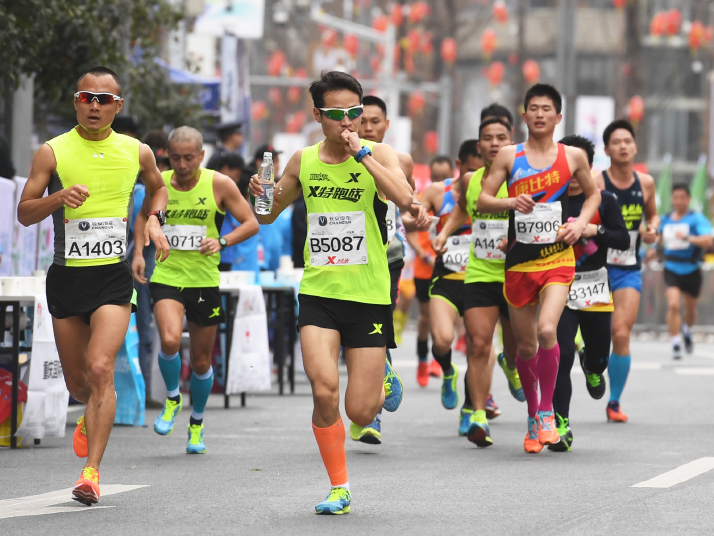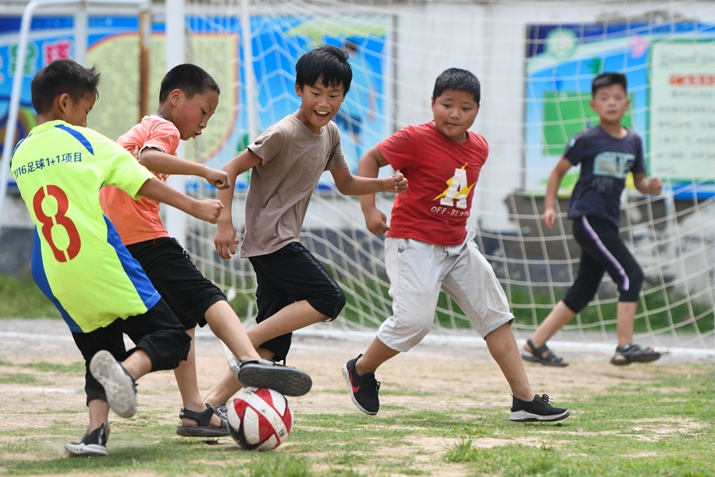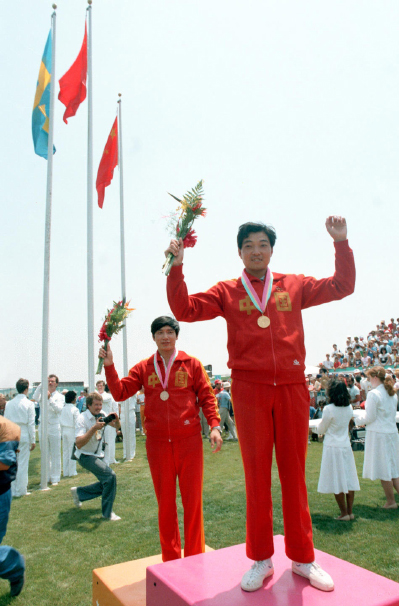| Editor's Choice |
| Ahead of the Game | |
| China launches drive to develop sports and improve people's health | |
|
|
 A marathon race in Chongqing Municipality in southwest China on March 19, 2017 (XINHUA)
At Beijing Sport University, there is a well-shaded path called Champion Road. It is a walk of fame honoring Olympic champions who have graduated from this top sport academy in China, with their footprints and signatures imprinted along the way. Near the road stands a statue of late Chinese leader Mao Zedong, who placed great importance on sports, and a sculpture of Pierre de Coubertin, the French educator who played a central role in restoring the Olympic Games in 1896. Champion Road epitomizes the country's glories and dreams in sports development. The first name on it is Xu Haifeng, the shooter who won the first Olympic gold for China at the 1984 Olympic Games in Los Angeles. Recently, recalling his first gold and sports development in China, Xu told the media, "Since its founding in 1949, the People's Republic of China (PRC) has constantly developed and changed. It is reaching the forefront of the world in many fields, including sports." "Now, China is growing from a big sports country to a strong one, which needs to meet higher standards. It means not only the development of competitive sports, but also the overall development of mass sports, the sports industry and sports culture," Xu said. In August, the State Council released the Outline for Building a Leading Sports Nation, which set the goal to develop China into a strong sports country by the year 2050. China is promoting public fitness. After the Beijing Olympic Summer Games in 2008, the day the games started, August 8, was designated National Fitness Day. In addition, fitness for all is one of the measures under the Healthy China initiative to enhance the overall health of Chinese people. Currently, Xu is a member of the national committee for promoting the initiative.  Children play football in Sanyi School, Fuyang City of Anhui Province in east China, on September 10 (XINHUA)
Faster, higher and stronger Over the past seven decades, China has made remarkable progress in sports, especially in competitive sports. As of the end of 2018, Chinese athletes had won 3,458 gold medals in international sports competitions such as World Cups and World Championships and 237 gold medals in Olympic Games, and broken 1,332 world records in various international competitions, according to the General Administration of Sport of China (GASC). Before 1949, China had never won a medal in any world sports competition. Liu Changchun was the first Chinese athlete to participate in the Olympic Games in Los Angeles in 1932 and was the only athlete from China that year. In 1936, China sent 69 athletes to compete in the Berlin Olympic Summer Games, and except for a pole vaulter, no other Chinese athlete made it to the semifinals. As the delegation passed through Singapore on the return journey, a local paper published a cartoon satirizing China as the "sick man of East Asia." After the PRC was established, sports were given more importance. Gou Zhongwen, head of the GASC, recalled in a published article that within 20 days after the PRC's birth, a national conference was held to discuss the development of sports, which spelled out the policies for sports development. In June 1952, Mao wrote an inscription celebrating the establishment of the All-China Sports Federation, which read, "Develop sports and strengthen people's physical fitness." In November 1952, a sports committee was set up to oversee the development of sports in China. The country adopted a whole-nation system to develop competitive sports. Under the system, talented children are selected and enter sport schools at a young age, where they are trained, with the qualified ones recruited into provincial and then national teams, and then selected to compete internationally. All expenses are covered by the government. The system has turned out to be effective, with many Chinese athletes making remarkable achievements. From 1949 to the end of the 1950s, 39 Chinese athletes smashed world records, and in 1959, table tennis player Rong Guotuan won the first world championship for China in the World Table Tennis Championships. Recalling his Olympic gold medal, Xu said, "After I played the last shot, the audience erupted." The momentous victory was documented in a video, in which the announcer says during the medal ceremony, "I want you to know that you are participating in something that is more historic than you may have ever imagined, because the gold and silver medals will be awarded to a country that has never won a medal in Olympic competition in our history." Since then, China has kept winning Olympic golds. From 15 gold medals in Los Angles in 1984 to 16 in Barcelona (1992) and 51 in Beijing (2008)…, Chinese athletes have won gold medals at every Olympic Games since, and in more events. Many legendary figures have emerged, including Chinese table tennis teams, diving teams and the Chinese women's volleyball team, which won five gold medals in two World Cups, two World Championships and an Olympic Games from 1981-86, and won the gold again at this year's World Cup in September. While continuing the whole-nation system, the government has also promoted the development of professional sports. The outline stated that the government supports coaches and athletes in developing professionally and forming professional associations. Nowadays, China not only participates in international sport games, but also hosts them. The country's long-cherished dream to host the Olympic Games was fulfilled in 2008, and recently, Wuhan in central China hosted the Seventh CISM Military World Games, where militaries from around the world flexed their muscles on the sports field rather than the battlefield. Moreover, Beijing and nearby Zhangjiakou in Hebei Province are gearing up to host the 2022 Olympic Winter Games.  Xu Haifeng receives the first Olympic gold medal for himself and China on July 29, 1984, at the Olympic Games in Los Angeles (XINHUA)
More fit As it gets stronger in competitive sports, China also wants to stress that sports are not just about winning medals. The outline on building the country into a leading sports nation spelled out measures for engaging more of the public in sports, improving competitive sports and enhancing the sports industry, sports culture and international sports exchange, including formulating preferential policies, providing funding, upgrading facilities and organizing mass fitness activities. The sport administration is placing emphasis on promoting mass sports to improve people's health, Gou said. Currently, 35 percent of people in China take part in sports regularly, he said. In the outline, the government set the goal to raise regular public participation in sports to above 45 percent by the year 2035 and have 92 percent of the people in the country meet the national physical fitness standards by then. In the early days of the PRC, as people were striving to keep themselves fed and clothed, fitness was not a big consideration. After the launch of reform and opening up in the late 1970s, as people's living standard gradually improved, aerobic exercises spread in China and commercial fitness clubs sprouted up. In the beginning, fitness clubs, many located in luxury hotels, targeted mainly high-end consumers. As the general public became more aware of fitness, the centers became more popularized. Meanwhile, the government has also been expanding sports facilities, with sports fields increasing from 4,982 in 1949 to about 3.1 million now, Gou said. The sports that the general public play have also become more colorful. Now, they not only engage in tai chi, dancing, jogging, swimming and playing ballgames, some also take up more challenging sports such as marathon running. According to Gou, in 2018, 1,581 marathons were held in 285 cities in 31 provinces, autonomous regions and municipalities, during which people participated in a total of 5.83 million runs. In addition, children are now trained in sports traditionally not common to China such as fencing, equestrian sports and ice hockey. Ge Zhengnan, 71, is a veteran marathon runner in Nantong of Jiangsu Province. Over the past 30 years, he has run in more than 100 marathons in various locations around the country and has been covered by the media numerous times. His most recent race was completed in Nantong on October 13. "I was once in poor health, suffering from high blood pressure and dizziness. My neighbors told me to start running to improve my health, and I haven't stopped since," he told the media. In the 1970s, he began middle- to long-distance running, and has covered a total distance of nearly 200,000 km, he said. Long-distance running has not only given him good health, but also the courage to challenge himself. This is exactly the kind of result the fitness for all measure and the Healthy China initiative aspire to achieve. By 2050, when China becomes a strong sports country, people's fitness and health levels, and its overall strength and influence in sports will be leading the world, the outline stated. Copyedited by Rebeca Toledo Comments to wanghairong@bjreview.com |
|
||||||||||||||||||||||||||||||
|
